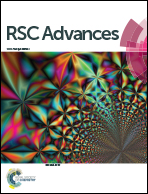Influence of anion hydration status on selective properties of a commercial anion exchange membrane electrochemically impregnated with polyaniline deposits
Abstract
There is currently great interest in the use of polyaniline (PAni) to impart particular properties to anion exchange membranes, employed in several fields. This special polymeric material can be obtained both chemically and electrochemically; however, the latter affords better control of morphology, which could be used to promote some properties of PAni-based membranes, such as their selectivity or hydrophobic/hydrophilic balance. In this work, commercially available membranes were electrochemically modified with PAni to improve their hydrophobic/hydrophilic balance, and this was achieved by cyclic voltammetry in acidic solutions. The performance of the modified membranes in the electrodialysis process of a nitrate–chloride mixture in neutral solutions was then evaluated. The impregnation imparts specific selective properties to the commercial membrane that lead to a greater retention of chloride ions. This property derives from the higher hydrophobicity of the PAni deposited on the membrane, which leads to a more effective exclusion of the more hydrated chloride anions.



 Please wait while we load your content...
Please wait while we load your content...